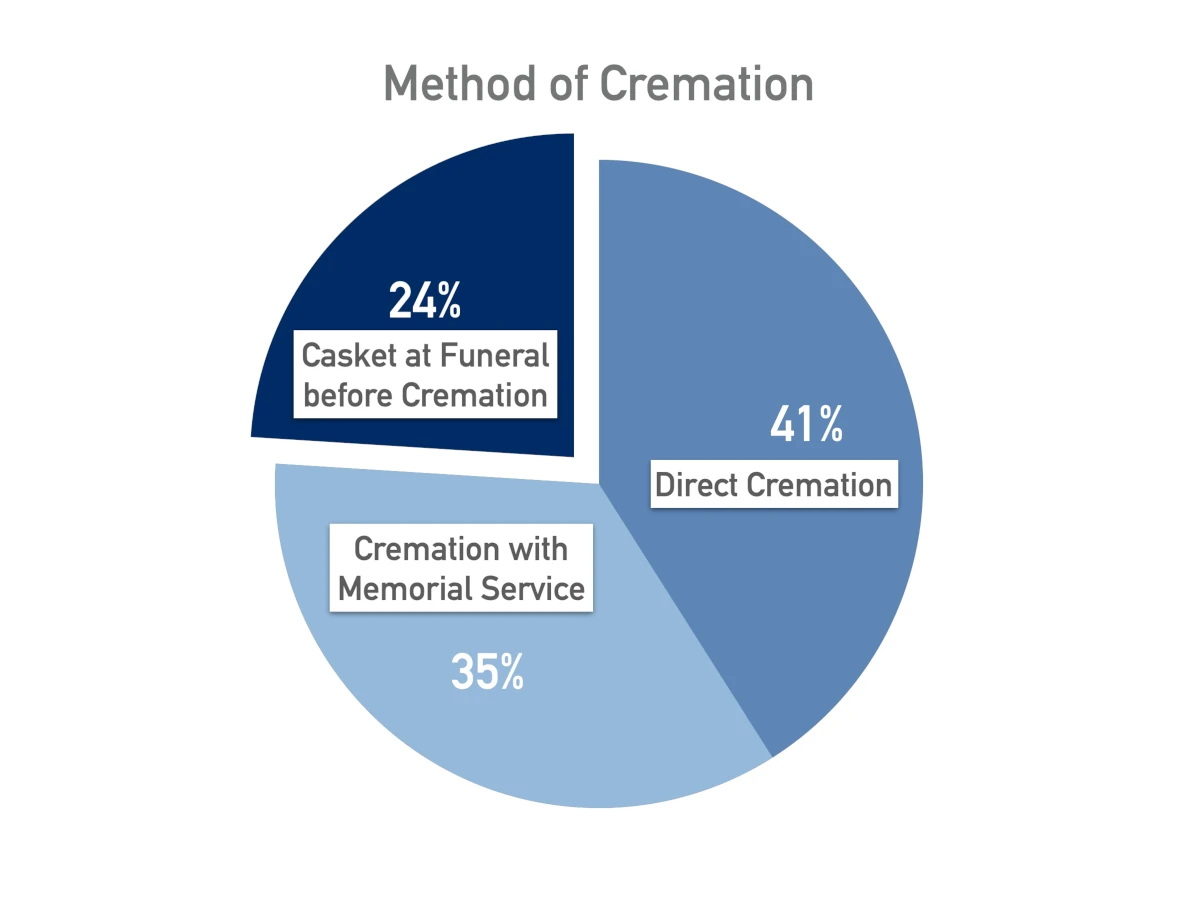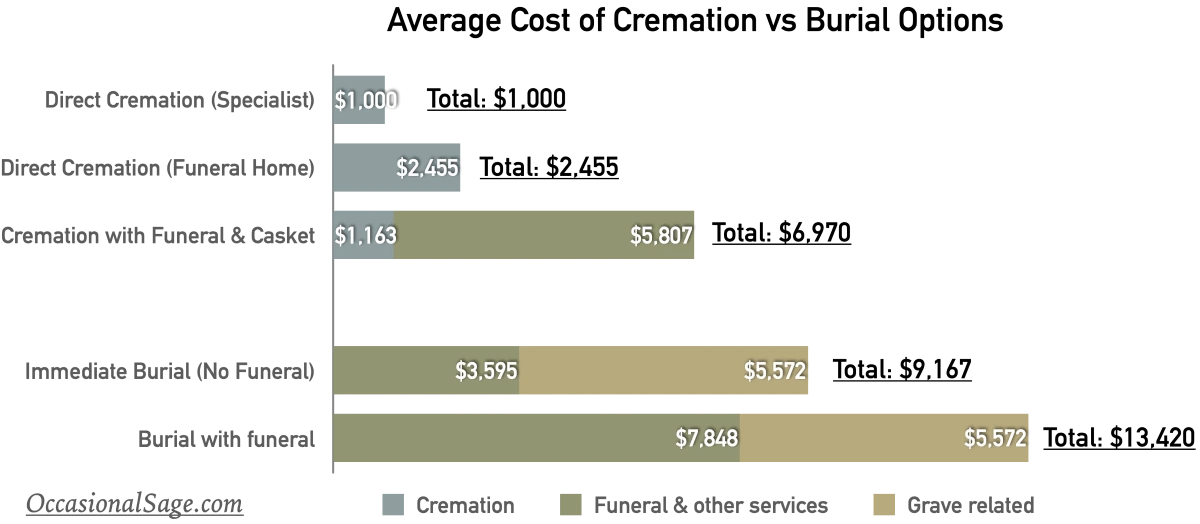Direct cremation is cremation immediately after death, without any prior embalming or ceremonies, such as a viewing or funeral. Losing a loved one is always a challenging time, and planning for end-of-life arrangements can be difficult. Direct cremation provides a more cost-effective and efficient option for families navigating this difficult period.
Understanding the direct cremation process, benefits, and considerations can help individuals and families make informed decisions about end-of-life arrangements. While the benefits to direct cremation include lower cost and simplicity, some families may desire more traditional ceremonies as part of their grieving processes.
Those most focused on price should opt for specialist direct cremation providers, whose prices can be 60% or more less than going through funeral homes.
Table of Contents
Understanding Direct Cremation
Definition
Direct cremation is a process in which a deceased person’s body is cremated without a traditional funeral or memorial service. It is a straightforward and cost-effective option for families who prefer a simple, no-frills approach to end-of-life arrangements.
Difference Between Traditional Cremation and Direct Cremation
Traditional cremation involves a public viewing or visitation, followed by a funeral service and then cremation. Direct cremation, on the other hand, skips these formalities and proceeds directly to the cremation process shortly after death.
Traditional cremation often includes embalming, renting a casket, and coordinating a funeral ceremony with speakers, music, and flowers. Direct cremation omits these elements, reducing both preparation time and cost. A sturdy cardboard box is often used for direct cremation.
Traditional cremation is often arranged through a funeral director at a funeral home, while direct cremation can be arranged through a funeral home or crematory.
In both cases, the cremated remains can be returned to the family in an urn or simple cremation container. Less expensive direct cremation services often don’t include an urn.
Why Choose Direct Cremation?
Direct cremation has several advantages, such as:
- Cost: Direct cremation costs significantly less than traditional cremation due to the absence of additional services and rentals.
- Flexibility: Family members can plan a memorial service or gathering on their own timeline separate from the cremation event, allowing for more personalization and convenience.
- Simplicity: For those who prefer minimal fuss, direct cremation offers a straightforward, no-frills option.
- Eco-friendly: Direct cremation can have a lower environmental impact compared to traditional cremation or burial practices; with fewer resources used for embalming, casket, and funeral services.

Potential Downsides of Direct Cremation
- Lack of a traditional funeral service: Direct cremation takes place without any form of funeral service beforehand. For some people, this can feel impersonal and may not provide the closure they need. Traditional funeral services often provide an opportunity for friends and family to say their goodbyes, share memories, and support each other.
- A memorial or celebration of life can still be arranged independently, it just won’t be provided from the funeral home.
- Limited opportunity for viewing: Direct cremation means that there is no viewing or visitation. This can be hard for family and friends who wish to see the deceased one last time.
- Some cremation providers may allow a private viewing before cremation takes place but this is not common among lower cost options. Family and close friends may have a chance to say goodbye directly after death before transporting the body to the crematorium.
- Less personalized: Direct cremation is generally a more straightforward, less personalized process. For people who wish for a unique ceremony that reflects the life and personality of the deceased, this might not be the best option.
- You can still add personalization through an independent memorial service or by personalizing the urn. You may consider scattering the ashes somewhere meaningful.
- Potential for regret: Some people may regret the decision to opt for direct cremation, particularly if they feel pressured into it because of cost considerations or time pressures.
- Cultural and religious considerations: In some cultures and religions, cremation is not accepted or is frowned upon, so this could be a downside for people from those backgrounds.
How Popular is Direct Cremation?
According to the National Funeral Directors Association (NFDA), 41% of cremations in 2021 were direct cremations. A further 35% of cremations included a memorial service and the remaining 24% chose to use a casket with traditional funeral and viewing followed by cremation.
The current rate of cremation in the US is 59.3%. The implies that direct cremation was chosen for 24.3% of Americans. 45.1% of Americans were cremated without using a casket for a viewing or funeral service.

- Direct cremation is the most common method of cremation chosen in the US based on information from the National Funeral Directors Association.
- Only 24% of cremations involve purchase of a casket and funeral service.
Direct Cremation Process Steps
The direct cremation process includes the following steps:
- Arranging for pickup and transportation: The body needs to be transported to the cremation facility. The cremation provider typically arranges for this.
- Death certificate and permits: The death must be officially registered, and a death certificate obtained. The cremation provider often assists with this process. Additionally, a permit for cremation (sometimes called a “disposition permit”) must be obtained, usually from the county health department.
- Authorization: Before a cremation can take place, a legal authorization form must be completed and signed by the next of kin or authorized decision maker. The cremation provider should provide this form.
- Preparation for cremation: Before cremation, certain preparations are necessary. This usually includes removing any items that cannot be cremated, such as pacemakers or certain types of jewelry. The body is then placed in a cremation casket or container, which must be combustible and meet certain requirements.
- Cremation: The actual process of cremation involves placing the body in a special furnace, called a cremator or retort, where it is exposed to high temperatures (generally between 1400 and 1800 degrees Fahrenheit) until it is reduced to bone fragments.
- Processing of remains: After cremation, the bone fragments are processed into a fine, sand-like consistency in a machine. This is what is typically referred to as “ashes” or “cremains”.
- Return of the ashes: The ashes are typically placed in an urn or other container and returned to the family or authorized person. Some cremation providers may also offer to scatter the ashes in a designated area, or the family can choose to do this themselves.
What to Know When Dealing with A Funeral Home
Funeral homes make a lot more revenue from traditional full service funerals with burials than they do from cremation, especially direct cremation. It is in their financial interests to recommend full service viewings, funerals and burials. For cremations with viewings and funeral services, funeral directors can still earn good income. They earn the least from direct cremations and so are incentivised to steer family members to another option.
While they may raise valid points about the benefits of fuller services, consider where their interests lie too.
Approximately 39% of funeral homes own their own crematory, so the majority do not earn significant income from providing cremation services. According to the NFDA, cremations cost 40% less than funerals with burials.
What the Funeral Rule says about direct cremations
The Federal Trade Commission’s Funeral Rule sets out the rules that funeral providers must follow when offering services to the public. It includes the following conditions:
- You cannot be forced to buy a casket for a direct cremation.
- Funeral homes must provide a price list of alternative containers (for example, cardboard or fibreboard) if they offer direct cremation.
- If you do choose to buy a casket or alternative container, you do not have to buy it from the funeral homes. You may purchase or arrange your own casket or alternative container yourself and they are required to accept it.
- The price quoted for direct cremation must include a price if you supply your own casket or container.
- The price for a direct cremation must cover basic services from the funeral home. This cannot be added separately.
Cost Comparison of Direct Cremation and Traditional Funerals
Direct cremation is a more cost-effective alternative to traditional funeral services. The main reason for this difference in cost is the simplicity of the direct cremation process. Traditional funerals involve several additional expenses such as embalming, casket, burial plot or vault, and possibly a viewing or visitation.

| Option | Cost | Difference from Direct Cremation |
| Direct cremation through specialist | $1,000 | – |
| Direct cremation through funeral home | $2,455 | $1,455 |
| Burial with traditional funeral (includes expenses related to the grave plot) | $13,420 | $12,420 |
| Immediate burial, no ceremonies | $9,167 | $8,167 |
| Cremation with traditional funeral and rental casket | $6,655 | $5,655 |
A direct cremation can cost over $12,000 less than a full service funeral with burial and over $5,000 less than a cremation with funeral service.
Direct Cremation Costs Cover:
- Cremation fee
- Transportation of the deceased
- Basic container for the ashes
- Required paperwork and permits
Direct cremation through a funeral home: $2,455
Direct cremation through a cremation specialist: $1,000
Direct cremation through a specialist provider costs 60% less than going through the average funeral home. Funeral homes charge higher prices for a few reasons. Firstly, they do not want to undercut their core profit centers. Charging too low a price would encourage more people to chose direct cremation. Secondly, they do not have the same efficiencies as specialist providers who only deal in cremation so they have to charge more to cover their overheads.
Traditional Funeral Costs Cover:
- Funeral home and director fees
- Embalming and body preparation
- Casket
- Burial plot and vault
- Viewing or visitation
- Hearse transportation
- Gravesite service
- Simple gravesite monument
Factors Influencing Cremation Costs
Several factors can influence the cost of a direct cremation. These include:
- Geographical Location: Cremation costs can vary significantly based on the region where the service takes place. Urban areas may have higher fees than rural locations and prices vary across states.
- Funeral Home vs Specialist Provider: The choice of funeral home or cremation specialist can substantially impact the overall cost.
- Additional Services: While direct cremation is a basic service, families may choose to add other services such as a memorial service, an urn or special container for the ashes, or even scattering the ashes in a specific location, all of which can increase the total cost.
1 thought on “What is Direct Cremation? What You Need to Know”